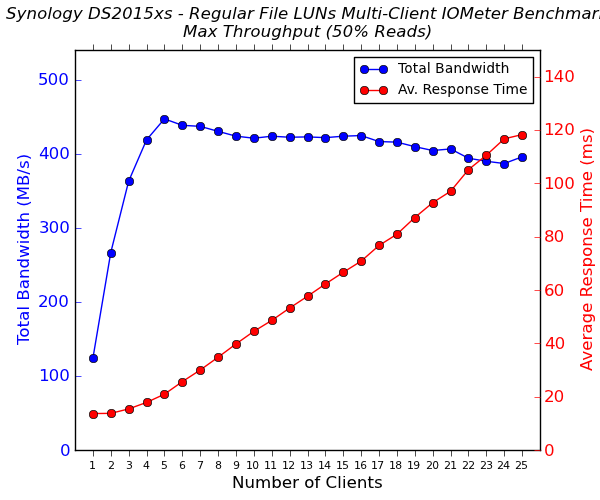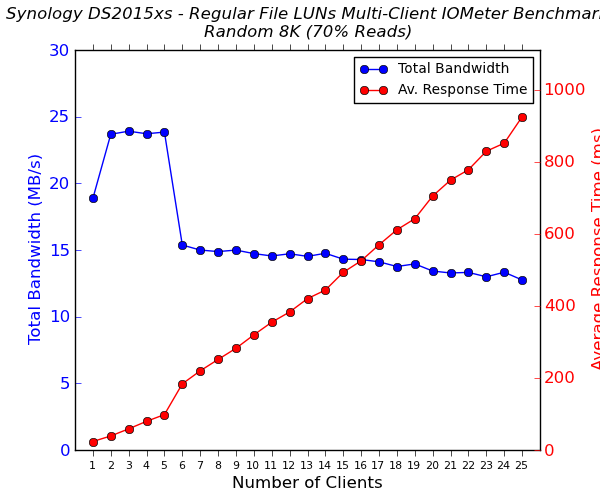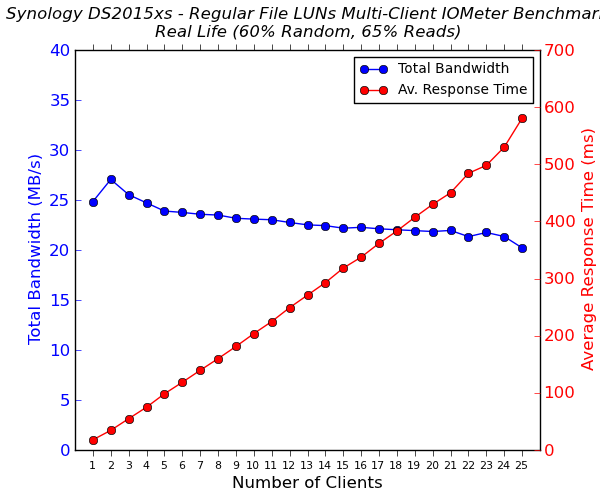Synology DS2015xs Review: An ARM-based 10G NAS
by Ganesh T S on February 27, 2015 8:20 AM EST- Posted in
- NAS
- Storage
- Arm
- 10G Ethernet
- Synology
- Enterprise
Multi-Client iSCSI Evaluation
As virtualization becomes more and more popular even in home / power user settings, the importance of the iSCSI feature set of any COTS NAS can't be overstated. Starting with our ioSafe 1513+ review, we have started devoting a separate section (in the reviews of NAS units targeting SMBs and SMEs) to the evaluation of iSCSI performance. Since we have already looked at the way iSCSI LUNs are implemented in DSM in the ioSafe 1513+ review, it won't be discussed in detail.
We evaluated the performance of the Synology DS2015xs with file-based LUNs as well as configuring a RAID-5 disk group with single as well as multiple LUNs. The standard IOMeter benchmarks that we used for multi-client CIFS evaluation were utilized for iSCSI evaluation also. The main difference to note is that the CIFS evaluation was performed on a mounted network share, while the iSCSI evaluation was done on a 'clean physical disk' (from the viewpoint of the virtual machine).
Performance Numbers
The four IOMeter traces were run on the physical disk manifested by mapping the iSCSI target on each VM. The benchmarking started with one VM accessing the NAS. The number of VMs simultaneously playing out the trace was incremented one by one till we had all 25 VMs in the fray. Detailed listings of the IOMeter benchmark numbers (including IOPS and maximum response times) for each configuration are linked below:
- Synology DS2015xs - 8 SSDs / RAID-5 / 2x 10G - LUNs (Regular Files)
- Synology DS2015xs - 8 SSDs / RAID-5 / 2x 10G - Single LUN on RAID
- Synology DS2015xs - 8 SSDs / RAID-5 / 2x 10G - Multiple LUNs on RAID




The observations we had in the previous section hold true here also. In general, the performance of the DS2015xs iSCSI volumes is better than the others that are presented as comparison points, even considering the SSD vs. HDD aspect.










49 Comments
View All Comments
chrysrobyn - Friday, February 27, 2015 - link
Is there one of these COTS boxes that runs any flavor of ZFS?SirGCal - Friday, February 27, 2015 - link
They run Syn's own format...But I still don't understand why one would use RAID 5 only on an 8 drive setup. To me the point is all about data protection on site (most secure going off site) but that still screams for RAID 6 or RAIDZ2 at least for 8 drive configurations. And using SSDs for performance fine but if that was the requirement, there are M.2 drives out now doing 2M/sec transfers... These fall to storage which I want performance with 4, 6, 8 TB drives in double parity protection formats.
Kevin G - Friday, February 27, 2015 - link
I think you mean 2 GB/s transfers. Though the M.2 cards capable of doing so are currently OEM only with retail availability set for around May.Though I'll second your ideas about RAID6 or RAIDZ2: rebuild times can take days and that is a significant amount of time to be running without any redundancy with so many drives.
SirGCal - Friday, February 27, 2015 - link
Yes I did mean 2G, thanks for the corrections. It was early.JKJK - Monday, March 2, 2015 - link
My Areca 1882 ix-16 raid controller uses ~12 hours to rebuild a 15x4TB raid with WD RE4 drives. I'm quite dissappointed with the performance of most "prouser" nas boxes. Even enterprise qnaps can't compete with a decent areca controller.It's time some one built som real NAS boxes, not this crap we're seeing today.
JKJK - Monday, March 2, 2015 - link
Forgot to mention it's a Raid 6vol7ron - Friday, February 27, 2015 - link
From what I've read (not what I've seen), I can confirm that RAID-6 is the best option for large drives these days.If I recall correctly, during a rebuild after a drive failure (new drive added) there have been reports of bad reads from another "good" drive. This means that the parity drive is not deep enough to recover the lost data. Adding more redundancy, will permit you to have more failures and recover when an unexpected one appears.
I think the finding was also that as drives increase in size (more terabytes), the chance of errors and bad sectors on "good" drives increases significantly. So even if a drive hasn't failed, it's data is no longer captured and the benefit of the redundancy is lost.
Lesson learned: increase the parity depth and replace drives when experiencing bad sectors/reads, not just when drives "fail".
Romulous - Sunday, March 1, 2015 - link
Another benefit of RAID 6 besides 2 drives being able to die, is the prevention of bit rot. In Raid 5, if i have a corrupt block, and one block of parity data, it wont know which one is correct. However since RAID 6 has 2 parity blocks for the same data block, its got a better chance if figuring it out.802.11at - Friday, February 27, 2015 - link
RAID5 is evil. RAID10 is where it's at. ;-)seanleeforever - Friday, February 27, 2015 - link
802.11at:cannot tell whether you are serious or not. but
RAID 10 can survive a single disk failure, RAID 6 can survive a failure of two member disks. personally i would NEVER use raid 10 because your chance of losing data is much greater than any raid that doesn't involve 0 (RAID 0 was a afterthought, it was never intended, thus called 0).
RAID 6 or RAID DP are the only ones used in datacenter for EMC or Netapp.